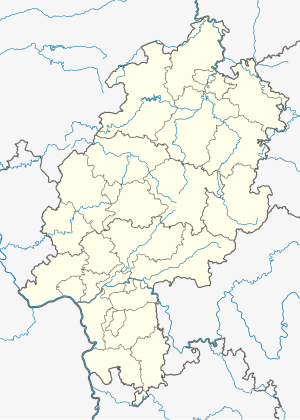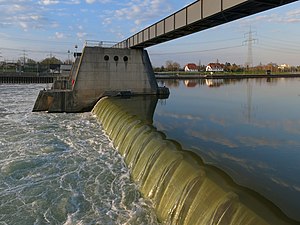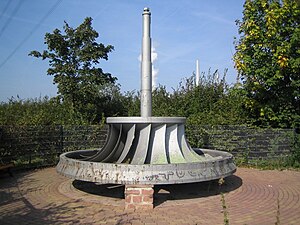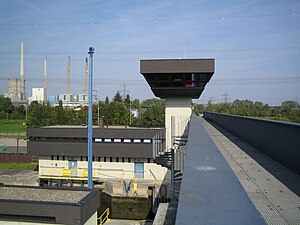Krotzenburg barrage
| Krotzenburg barrage | ||
|---|---|---|
| location | ||
|
|
||
| Coordinates | 50 ° 4 '48 " N , 8 ° 57' 38" E | |
| country |
|
|
| place |
Großkrotzenburg Klein-Krotzenburg |
|
| Waters | Main | |
| Kilometers of water | km 63.85 | |
| power plant | ||
| construction time | 1915-1920 1979-1983/2010 |
|
| technology | ||
| Bottleneck performance | 1.76 megawatts | |
| Average height of fall |
2.74 m | |
| Expansion flow | 90 m³ / s | |
| Turbines | 4 VLH turbines | |
| Others | ||
The Krotzenburg barrage is a weir with a lock and part of the Main Federal Waterway at km 63.85. It is subordinate to the Aschaffenburg Waterways and Shipping Authority . The two communities of Großkrotzenburg on the north bank of the Main and the Hainburg district of Klein-Krotzenburg on the south bank of the Main are connected via the pedestrian walkway of the lock . The next barrage down the Main is the Mülheim barrage, after the Kesselstadt barrage was demolished in 1987-89. Since the Großwelzheim barrage was demolished in 1970, Kleinostheim has been the next barrage up the Main.
technology
The weir of the barrage is divided into three segments. The damming in each segment is carried out by lowerable flap weirs with a weir closure 36 m wide, which dams the water up to a drop height of 2.74 m. On the northern side of the Main on the Großkrotzenburger side there are the two lock chambers for large ships and a boat lock. The northernmost chamber is still based on the old lock from 1921. The water requirement for a filling is 11,000 cubic meters, which takes about ten minutes. The effective length of the two lock chambers is 300 and 302 m respectively, with a respective effective width of 12 m.
The lock chambers have been remote-controlled from a control center of the WSA Aschaffenburg since June 2014. The boat lock is still operated by the users themselves and has a usable length of 19.65 m with a width of 4.00 m.
Planned use of hydropower
In March 2008, the Aschaffenburg Waterways and Shipping Office commissioned Juwi with the project development of a hydropower plant , which will pay a fixed amount to the federal treasury every year after completion, regardless of the actual electricity generation.
According to initial plans, four so-called very low head turbines (VLH) will be used in the southernmost weir segment on the Klein-Krotzenburger side of the lock , which generate electrical energy particularly efficiently from the low head of 2.74 m. In the design, special attention is paid to the fish-friendliness and the trouble-free flood flow without requiring structural changes to the previous barrage. The planned nominal output of the power plant is 4 × 440 kW.
At the end of 2014, the majority of the Juwi company was taken over by the Mannheim-based utility MVV Energie AG, which meant that all ongoing projects were given a new priority. Although the main points for the granting of building rights have already been processed by the Darmstadt Regional Council, the company is looking for a cooperation partner for the use of hydropower at the Krotzenburg barrage before the project can be continued.
history
After the canalisation of the Lower Main from its mouth to Frankfurt at the end of the 19th century, the Main was canalised up to Aschaffenburg in a second phase until 1921 . During this phase, the Krotzenburg barrage was built from 1915 to 1920. At that time it was the first with a modern roller weir (drum weir) .
As part of a renewal phase of the main barrages, a new barrage was built near Krotzenburg further down the Main between 1979 and 1983. The low head made the use of hydropower not economical at the time, and so no hydropower plant was built in.
After the construction and commissioning of the new barrage, work began on demolishing the old one. The last tough process turned out to be the demolition of the power station building, which was carried out with a jackhammer and explosives.
On the Großkrotzenburg side, an old turbine wheel reminds of the place of the old barrage. On the other side of the Main is a sculpture called “Old Lock”.
In June 1997 there was a serious accident at the lock in which three young employees from the Aschaffenburg Waterways and Shipping Office were killed. Two boats manned by workers capsized. A memorial plaque on the Klein-Krotzenburger side commemorates the deceased.
Web links
Individual evidence
- ↑ a b http://www.wsa-aschaffenburg.wsv.de/02_wirueberuns/05_Chroniken/WSA_Aschaffenburg/index.html ; accessed on January 6, 2018
- ↑ a b Information board at the Krotzenburg barrage
- ↑ Großkrotzenburg.de; accessed on April 1, 2017 ( Memento from June 20, 2006 in the Internet Archive )
- ↑ http://www.wsv.de/ftp/presse/2014/00191_2014.pdf ; accessed on October 7, 2014
- ↑ We generate electricity from hydropower at juwi.de
- ↑ Wehr will soon generate electricity In: OP-Online, August 7, 2009
- ↑ Martin Brust: Strom from the Strom . In: Frankfurter Rundschau of March 24, 2009
- ^ Hydropower plant in Krotzenburg on op-online from February 22, 2010
- ↑ Wolfgang Kleef: Project for the construction of a hydropower plant at the Main barrage Krotzenburg , Water Neighborhood Main (East), Implementation of the EU WFD on the Federal Waterway Main, Darmstadt Regional Council, RPAU Darmstadt, Department 41.2 Surface Waters, September 2009, accessed on September 3, 2011
- ^ Hydroelectric power station in Krotzenburg In: OP-Online, February 22, 2010; Retrieved September 3, 2011.
- ↑ When will the hydropower plant in Großkrotzenburg come? In: Main-Echo.de , August 30, 2016; accessed on March 31, 2017.
- ^ WSA Aschaffenburg: On the history of the Main waterway, accessed April 3, 2017
- ^ "Three dead in an accident at the Großkrotzenburger Schleuse", Frankfurter Allgemeine Zeitung, June 10, 1997








